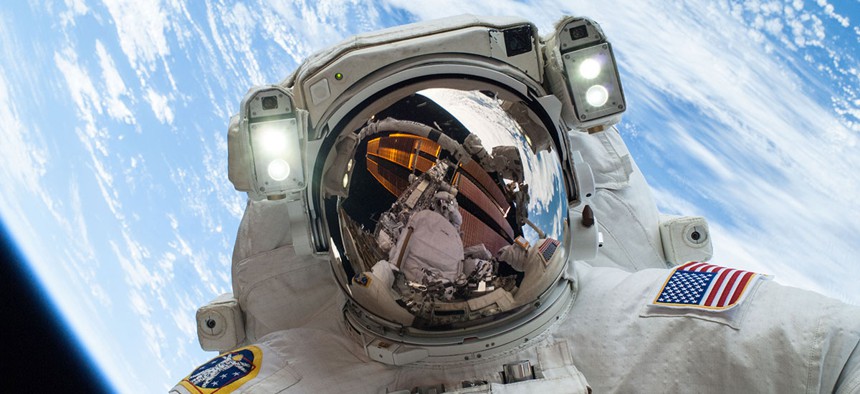These NASA Inventions Save Thousands of Lives on Earth
You can thank the agency for personal locator beacons.
When most people think of NASA, they think of astronauts, space shuttles and men on the moon. What’s less well known is that in making space travel possible, the US space agency has created new technology that’s saving lives all over the planet.
NASA’s Technology Transfer Program makes the technologies it develops for space missions accessible to the public. Once NASA’s inventions are patented, they become available for further development and use in consumer products. Since this program’s founding in 1964, the ripple effects of space technology have been felt around the world. Here are a few of the highlights:
View from above
In 1994, NASA began an effort to map Earth’s topography. The project eventually resulted in the discovery of approximately 66 trillion gallons of water beneath drought-stricken northwest Kenya in 2013.
It all began with the Spaceborne Imaging Radar, which used radio waves to map topography aboard the Endeavor space shuttle in 1994. The radar had high-resolution capabilities that allowed it to work in total darkness, penetrating clouds and dense forests alike. It could even map geological features below Earth’s surface. The goal was to use the maps to study environmental issues such as deforestation in the Amazon.
After the topography images became available to private companies, one firm, Radar Technologies International (RTI), began using them to search for evidence of diamonds, gold, and other commodities. But Alain Gachet, the CEO of RTI, realized that he could also see evidence of heavy moisture underground. He began developing a process to find undiscovered sources of water.
His proprietary process, known as the WATEX System, “removes surface obstacles” such as large rock formations from the data sets in order to locate soil moisture. Gachet added data from NASA’s satellite program and other sources to find the chemical composition of rocks and landscape surfaces, which allowed the system to identify where water might accumulate. But he still didn’t know exactly where to dig—or how deep to go.
NASA supplied the missing piece of information in the form of the Shuttle Radar Topography (SRT) Mission. During 11 days of low orbit around the Earth, SRT mapped most of the earth’s ground features. These detailed images provided clues as to where groundwater might be found.
Since 2004, the WATEX diving rod has discovered new sources of water in places including Chad, Afghanistan, Angola, Sudan and Texas as well as Kenya. In the 2015 Spinoff report, Gachet expressed his pride in the Kenya discovery.
“Discovering a little water brings war,” he said, “but discovering a lot of water can bring peace, because everyone can share it.”
Finding the human heartbeat
When a 7.8 magnitude earthquake struck Nepal in 2015, four men survived thanks to NASA technology that allows rescue workers to detect heartbeats through noise, rubble, dirt, snow, and just about any physical obstacle.
NASA’s Jet Propulsion Laboratory began developing the technology at the request of the US Federal Emergency Management Agency (FEMA). The agency wanted a way to find human heartbeats beneath collapsed buildings.
NASA scientists created a scanner that sends a low-powered microwave signal—about one-thousandth of a cell phone’s output—down into rubble. Changes in the reflections of those signals, caused by human heartbeats or breathing, make it possible to locate survivors.
The prototype of the device, Finding Individuals for Disaster and Emergency Response (FINDER), fits into a container the size of a carry-on suitcase and weighs about 20 pounds. FINDER collects motion data for 30 seconds every 10 to 20 feet, and then analyzes it using a logarithm to determine whether a person is in that area. The search follows the same grid patter used by human and canine rescue teams.
The device is programmed to take a picture of each scanned location to correspond with GPS coordinates. All of this data can then be transferred to a search grid. It can detect multiple heartbeats under 30 feet of rubble in the rain, at night and underwater. It can even distinguish between human and animal heartbeats.
Fieldwork helped NASA researchers determine how to include FINDER into the search and rescue process.
“We worked with the Virginia Task Force One at the Fairfax County Fire Department training center,” says Jim Lux, who worked on the project at the Jet Propulsion Laboratory in Pasadena, California. “We learned how searchers work. There’s a difference between detecting and locating a victim.”
A needle locator in Earth’s haystack
Movies and dramatic real-life rescues have made it seem almost easy to locate distress signals. Anyone who goes trekking in the Gobi Desert or hiking the Appalachian Trail can be found, right? Thanks to NASA’s partnership with 41 other countries, however, the answer is yes.
The agency’s Search and Rescue Satellite Aided Tracking (SARSAT) system enables distress signals from personal locator beacons to be sent to satellites in low-Earth orbit (180-2,000 km above the earth), connecting longitude and latitude coordinates and transmitting them to ground stations. The stations then distribute signal positions and other useful data to rescue centers so they can dispatch help.
There are still some hiccups to overcome. The process takes up to two hours, and the coordinates aren’t precise. Right now, multiple countries are developing technology to upgrade the system to include satellites in middle-Earth orbit (2,000-37,580 km above the earth). These improvements will be “a game changer” in pinpointing the search radius, says Lisa Mazzuca, NASA search and rescue mission manager.
“Once the program transitions to [middle-Earth orbit] spacecraft, the detection and location of a beacon will be nearly instantaneous anywhere on Earth,” she says.
The 2012 test of NASA’s first prototype proved that the new beacon technology could locate the signal within 1 km (0.6 miles) accuracy after the first burst, with accuracy improving to about 100 meters (328 feet) after 30 minutes. A current beacon has an accuracy of approximately 1 km after 30 minutes.
Over 1 million registered beacons are in use worldwide, and NASA plans to increase the number of satellites in circulation from 12 to 23 after the upgrade. So far, the beacons have already saved the lives of more than 35,000 people.
NEXT STORY: How a Marine Confronts Fear, and Overcomes It



